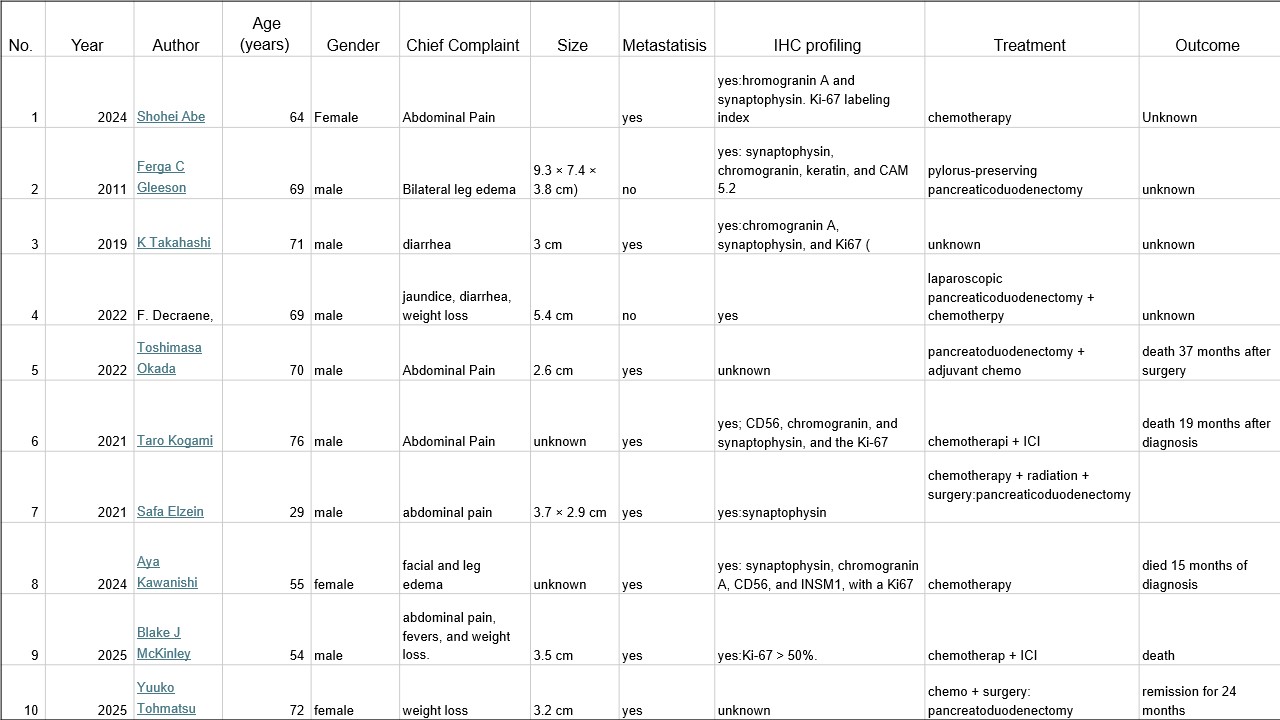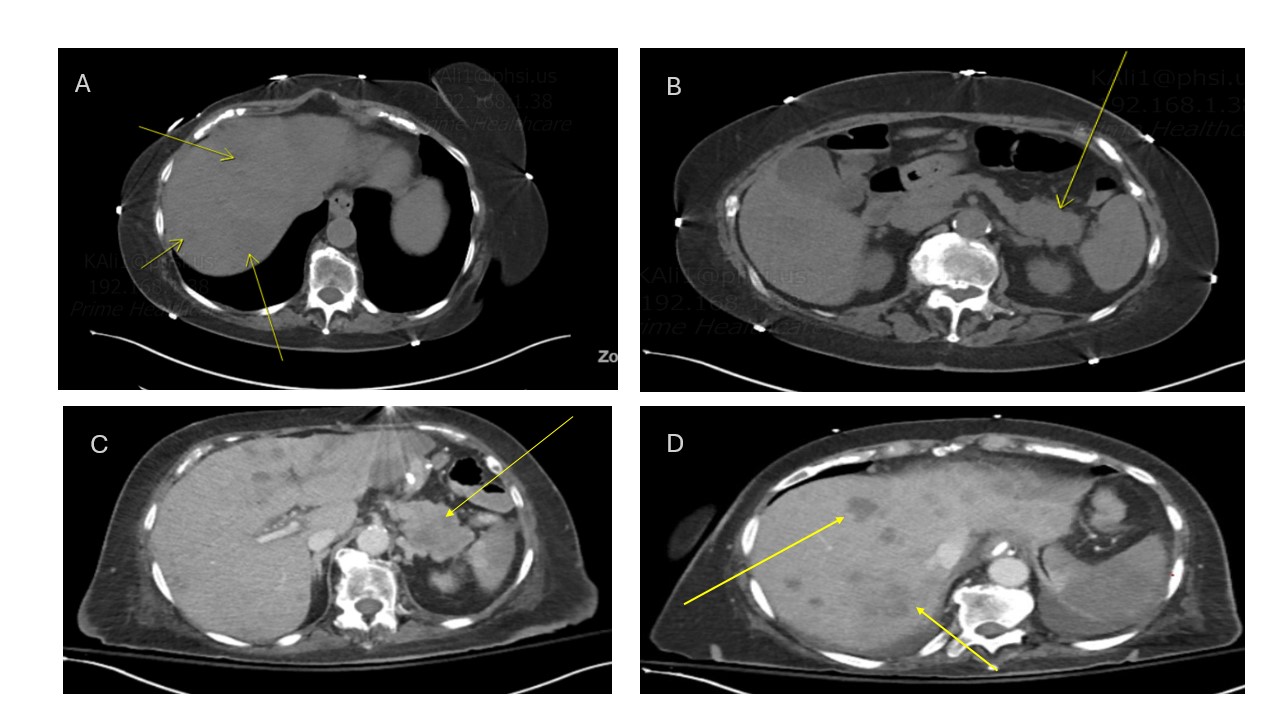Monday Poster Session
Category: Biliary/Pancreas
P2364 - Pancreatic Neuroendocrine Carcinoma: A Rare Case Report and Systematic Review of the Literature
Monday, October 27, 2025
10:30 AM - 4:00 PM PDT
Location: Exhibit Hall

Kashif Ali, MD
University of Texas Rio Grande Valley
Edinburg, TX
Presenting Author(s)
Kashif Ali, MD1, Samreen Jawaid, MD2, Asif Zamir, MD, FACG3
1University of Texas Rio Grande Valley, Edinburg, TX; 2Indiana University School of Medicine, Indianapolis, IN; 3DHR Health Gastroenterology, Edinburg, TX
Introduction: Pancreatic neuroendocrine neoplasms pNEN are rare epithelial tumors accounting for 1-2% of all pancreatic neoplasms categorized into well-differentiated neuroendocrine tumors (pNET) and poorly differentiated neuroendocrine cancer (pNEC). pNEC are characterized by Ki67 index > 29% and poorly differentiated nuclear atypia. They are often locally advanced and unresectable at diagnosis with poor prognosis even after curative excision. Herein, we present the case of a female with pNEC with stable disease following chemotherapy and systematic review of previously diagnosed cases of pNEC.
Case Description/
Methods: A 77-year-old female with a medical history of hypertension, hypothyroidism, and rheumatoid arthritis presented to the emergency department with abdominal pain and diarrhea ongoing for two weeks. The patient also reported unintentional weight loss and decreased oral intake. On arrival, physical examination was positive for tachycardia and epigastric tenderness and rest unremarkable. Complete blood count and renal function revealed Hemoglobin 11.8 g/dL, Platelets 172 × 10⁹/L, BUN 18 mg/dL, Creatinine 0.89 mg/dL and normal liver enzymes. Abdominal imaging revealed a mass in the pancreatic tail and numerous hepatic metastases. A gastrointestinal PCR panel was negative for infectious etiology. Tumor markers showed CA 19-9 of 36 and CEA of 27.4. Liver biopsy pathology was consistent with a malignant, poorly differentiated, high-grade pNEC. Immunohistochemistry (IHC) showed strongly positive synaptophysin,CK19,DPC4, and Ki-67 30% activity, The patient started on carboplatin and etoposide. Follow-up imaging at four months demonstrated stable disease with no evidence of progression.
Discussion: We identified 10 previously reported cases of pancreatic neuroendocrine carcinomas (pNECs), plus our own, through a PubMed/MEDLINE search up to March 2025. The average age was 62.9 years and the male-to-female ratio of 7:1. Abdominal pain was the most common symptom (5 cases). All patients received chemotherapy; 4 underwent surgery, and 3 received immune checkpoint inhibitors. IHC profiling—using CK, synaptophysin, chromogranin A, and Ki-67—was performed in 8 cases and remains essential for diagnosis. Surgery is the only curative option; chemotherapy is used for advanced disease. Emerging data support molecular therapies, with 2 patients receiving novel immunotherapy. This review highlights that pNECs, though rare, are aggressive tumors requiring early diagnosis and intervention for optimal outcomes.

Figure: Systematic Review of Reported Cases: Demographics and Study Characteristics

Figure: CT scan images A and B show liver and pancreatic masses, while images C and D demonstrate stable disease following chemotherapy
Disclosures:
Kashif Ali indicated no relevant financial relationships.
Samreen Jawaid indicated no relevant financial relationships.
Asif Zamir indicated no relevant financial relationships.
Kashif Ali, MD1, Samreen Jawaid, MD2, Asif Zamir, MD, FACG3. P2364 - Pancreatic Neuroendocrine Carcinoma: A Rare Case Report and Systematic Review of the Literature, ACG 2025 Annual Scientific Meeting Abstracts. Phoenix, AZ: American College of Gastroenterology.
1University of Texas Rio Grande Valley, Edinburg, TX; 2Indiana University School of Medicine, Indianapolis, IN; 3DHR Health Gastroenterology, Edinburg, TX
Introduction: Pancreatic neuroendocrine neoplasms pNEN are rare epithelial tumors accounting for 1-2% of all pancreatic neoplasms categorized into well-differentiated neuroendocrine tumors (pNET) and poorly differentiated neuroendocrine cancer (pNEC). pNEC are characterized by Ki67 index > 29% and poorly differentiated nuclear atypia. They are often locally advanced and unresectable at diagnosis with poor prognosis even after curative excision. Herein, we present the case of a female with pNEC with stable disease following chemotherapy and systematic review of previously diagnosed cases of pNEC.
Case Description/
Methods: A 77-year-old female with a medical history of hypertension, hypothyroidism, and rheumatoid arthritis presented to the emergency department with abdominal pain and diarrhea ongoing for two weeks. The patient also reported unintentional weight loss and decreased oral intake. On arrival, physical examination was positive for tachycardia and epigastric tenderness and rest unremarkable. Complete blood count and renal function revealed Hemoglobin 11.8 g/dL, Platelets 172 × 10⁹/L, BUN 18 mg/dL, Creatinine 0.89 mg/dL and normal liver enzymes. Abdominal imaging revealed a mass in the pancreatic tail and numerous hepatic metastases. A gastrointestinal PCR panel was negative for infectious etiology. Tumor markers showed CA 19-9 of 36 and CEA of 27.4. Liver biopsy pathology was consistent with a malignant, poorly differentiated, high-grade pNEC. Immunohistochemistry (IHC) showed strongly positive synaptophysin,CK19,DPC4, and Ki-67 30% activity, The patient started on carboplatin and etoposide. Follow-up imaging at four months demonstrated stable disease with no evidence of progression.
Discussion: We identified 10 previously reported cases of pancreatic neuroendocrine carcinomas (pNECs), plus our own, through a PubMed/MEDLINE search up to March 2025. The average age was 62.9 years and the male-to-female ratio of 7:1. Abdominal pain was the most common symptom (5 cases). All patients received chemotherapy; 4 underwent surgery, and 3 received immune checkpoint inhibitors. IHC profiling—using CK, synaptophysin, chromogranin A, and Ki-67—was performed in 8 cases and remains essential for diagnosis. Surgery is the only curative option; chemotherapy is used for advanced disease. Emerging data support molecular therapies, with 2 patients receiving novel immunotherapy. This review highlights that pNECs, though rare, are aggressive tumors requiring early diagnosis and intervention for optimal outcomes.

Figure: Systematic Review of Reported Cases: Demographics and Study Characteristics

Figure: CT scan images A and B show liver and pancreatic masses, while images C and D demonstrate stable disease following chemotherapy
Disclosures:
Kashif Ali indicated no relevant financial relationships.
Samreen Jawaid indicated no relevant financial relationships.
Asif Zamir indicated no relevant financial relationships.
Kashif Ali, MD1, Samreen Jawaid, MD2, Asif Zamir, MD, FACG3. P2364 - Pancreatic Neuroendocrine Carcinoma: A Rare Case Report and Systematic Review of the Literature, ACG 2025 Annual Scientific Meeting Abstracts. Phoenix, AZ: American College of Gastroenterology.
